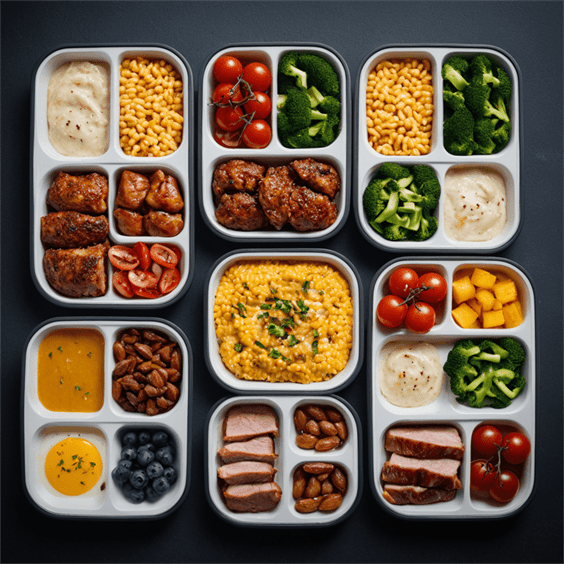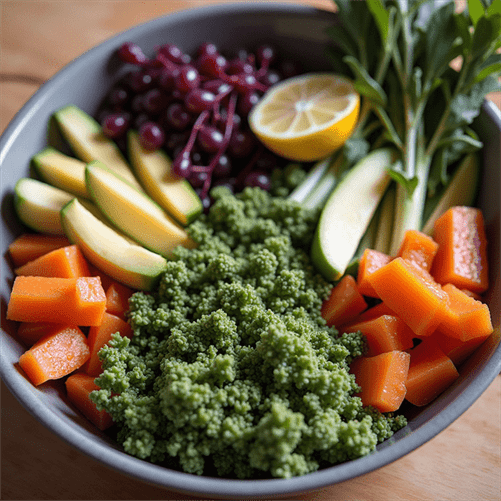
If you’ve ever tried to reduce carbs only to find yourself ravenous and reaching for snacks by mid-afternoon, you’re not alone. The key to success on a low-carb diet isn’t just cutting carbs—it’s strategically replacing them with the right balance of satisfying nutrients. This 7-day meal plan is designed to keep hunger at bay while helping you enjoy the benefits of a low-carb meal, from stable energy levels to reduced cravings and potential weight loss.
Why Meal Planning Helps Control Hunger

Transitioning to a low-carb lifestyle can be challenging without proper planning. Here’s why a structured meal plan is your secret weapon against hunger:
Prevents Decision Fatigue
When hunger strikes, willpower diminishes. Having meals planned in advance eliminates last-minute decisions that often lead to convenient but carb-heavy choices. Research published in the Journal of Consumer Research shows that we make poorer dietary choices when mentally fatigued—something a good meal plan helps prevent.
Ensures Nutritional Balance
A common mistake in low-carb diets is focusing exclusively on protein while neglecting healthy fats and fiber-rich vegetables. A well-designed meal plan ensures you’re getting the optimal balance of nutrients that work synergistically to keep you satisfied.
Stabilizes Blood Sugar
Perhaps most importantly, consistent meal timing and composition help maintain stable blood glucose levels. The dramatic spikes and crashes associated with high-carb diets are a primary driver of hunger and cravings. A structured low-carb plan helps flatten these curves, resulting in more consistent energy and fewer hunger pangs.
The Best Balance of Protein, Fats, and Fiber
Protein: The Hunger-Fighting MVP
Numerous studies have identified protein as the most satiating macronutrient. A 2015 study in the American Journal of Clinical Nutrition found that high-protein meals increase feelings of fullness and reduce subsequent calorie intake compared to lower-protein alternatives.
For optimal satiety on a low-carb diet, aim for:
- 25-30g of protein per meal (approximately 1.6-2g per kg of body weight daily)
- Include protein in every meal and snack
- Focus on complete proteins containing all essential amino acids
Healthy Fats: The Satisfaction Factor
Contrary to outdated dietary advice, fat doesn’t make you fat—it helps keep you full. Healthy fats slow gastric emptying, meaning food stays in your stomach longer, extending the feeling of satisfaction after meals. They also support the production of satiety hormones like cholecystokinin (CCK).
For a satisfying low-carb approach, incorporate:
- 1-2 tablespoons of healthy oils (olive, avocado, coconut) per meal
- Whole food fat sources like avocados, nuts, seeds, and fatty fish
- Full-fat dairy (if tolerated) rather than reduced-fat versions
Fiber: The Unsung Hero
While technically a carbohydrate, fiber doesn’t raise blood sugar like digestible carbs. Instead, it adds bulk to meals, slows digestion, and feeds beneficial gut bacteria that help regulate hunger hormones.
For hunger control without carb loading:
- Aim for 25-35g of fiber daily
- Focus on non-starchy vegetables as your primary fiber source
- Include small amounts of high-fiber, low-net-carb foods like chia seeds, flaxseeds, and avocados
Easy Low-Carb Meal Prep Ideas
The key to successful low-carb eating is preparation. These meal prep strategies take just a few hours on the weekend but save countless hours—and hunger pangs—during the busy week.
Protein Batch Cooking
- Rotisserie Chicken Versatility: Purchase two rotisserie chickens. Shred one for quick salads, lettuce wraps, and casseroles; portion the other into individual servings for grab-and-go protein.
- Sheet Pan Proteins: Marinate 3-4 pounds of chicken thighs, steak strips, or firm fish fillets in different seasonings, then roast on sheet pans for variety throughout the week.
- Egg Muffins: Whisk 12 eggs with chopped vegetables, cheese, and pre-cooked meats, then bake in a muffin tin for portable breakfasts and snacks.
Vegetable Preparation
- Roasted Vegetable Medley: Roast large batches of low-carb vegetables like zucchini, bell peppers, broccoli, and cauliflower with olive oil and seasonings. These can be reheated or enjoyed cold.
- Spiralized Vegetables: Prepare zucchini, cucumber, or daikon radish noodles to use as pasta alternatives throughout the week.
- Keto Slaw Kit: Shred cabbage, Brussels sprouts, and broccoli stems, but store separately from your prepared dressing to maintain crispness. Combine only when ready to eat.
Smart Fat Preparations
- Compound Butter: Mix softened butter with herbs, spices, or citrus zest, then reform and slice for instant flavor additions to proteins and vegetables.
- Dressing Jars: Prepare 2-3 homemade vinaigrettes or creamy dressings in mason jars for the week.
- Fat Bombs: For those following a ketogenic approach, prepare sweet or savory fat bombs—small, portioned bites high in healthy fats that help meet daily fat requirements and satisfy cravings.
What a Full Day of Low-Carb Eating Looks Like

Below is a sample day from our 7-day meal plan, illustrating the balance of nutrients and meal timing that helps control hunger while keeping carbs low.
Breakfast (7-8 AM)
Avocado Baked Eggs with Bacon
- 2 eggs baked in half an avocado
- 2 slices bacon
- ¼ cup sautéed spinach with garlic
- Coffee with 1 Tbsp heavy cream or coconut milk
Nutrition: 505 calories, 41g fat, 6g net carbs, 25g protein
Mid-Morning (10-11 AM, if needed)
Quick Fat-Protein Snack
- 1 string cheese
- 10 almonds
Nutrition: 160 calories, 13g fat, 2g net carbs, 9g protein
Lunch (12-1 PM)
Taco Salad Bowl
- 4 oz seasoned ground beef
- 2 cups mixed greens
- ¼ cup each: diced tomatoes, sliced bell peppers, diced avocado
- 2 Tbsp sour cream
- 2 Tbsp salsa (no added sugar)
- 1 Tbsp olive oil mixed with lime juice as dressing
Nutrition: 495 calories, 37g fat, 8g net carbs, 29g protein
Mid-Afternoon (3-4 PM)
Savory Greek Yogurt
- ½ cup full-fat Greek yogurt
- 1 Tbsp olive oil
- 1 Tbsp chopped cucumber
- ½ tsp dried herbs
- Pinch of salt and pepper
Nutrition: 165 calories, 13g fat, 3g net carbs, 10g protein
Dinner (6-7 PM)
Herb-Butter Salmon with Roasted Vegetables
- 5 oz salmon fillet with herb butter
- 1 cup roasted Brussels sprouts
- ½ cup cauliflower mash with cream cheese
- Side salad with 1 Tbsp olive oil and vinegar dressing
Nutrition: 585 calories, 42g fat, 11g net carbs, 35g protein
Evening (if needed)
Cinnamon Almond Milk
- 1 cup unsweetened almond milk
- ½ tsp cinnamon
- ½ tsp vanilla extract
- 1 Tbsp heavy cream
Nutrition: 85 calories, 8g fat, 1g net carbs, 1g protein
Daily Totals: 1,995 calories, 154g fat, 31g net carbs, 109g protein
The Complete 7-Day Low-Carb Meal Plan
Monday
- Breakfast: Avocado Baked Eggs with Bacon
- Lunch: Taco Salad Bowl
- Dinner: Herb-Butter Salmon with Roasted Vegetables
Tuesday
- Breakfast: Keto Smoothie (almond milk, avocado, spinach, protein powder, chia seeds)
- Lunch: Chicken Caesar Lettuce Wraps
- Dinner: Zucchini Noodles with Garlic Cream Sauce and Italian Sausage
Wednesday
- Breakfast: Cheesy Spinach Omelet with Avocado
- Lunch: Cauliflower “Potato” Salad with Hard-Boiled Eggs and Bacon
- Dinner: Baked Pesto Chicken Thighs with Roasted Broccoli
Thursday
- Breakfast: Coconut Flour Pancakes with Butter and Berries
- Lunch: Greek Salad with Grilled Chicken and Olive Oil Dressing
- Dinner: Beef and Broccoli Stir-Fry (no rice)
Friday
- Breakfast: Bacon and Egg Cups with Cheddar and Chives
- Lunch: Tuna Salad Stuffed Avocados
- Dinner: Butter-Basted Ribeye with Garlic Mushrooms and Asparagus
Saturday
- Breakfast: Crustless Quiche with Spinach, Feta, and Sun-Dried Tomatoes
- Lunch: Thai-Inspired Chicken Lettuce Wraps
- Dinner: Baked Cod with Herb Butter and Ratatouille
Sunday
- Breakfast: Cream Cheese Pancakes with Whipped Cream and Berries
- Lunch: Cobb Salad with Ranch Dressing
- Dinner: Slow Cooker Pulled Pork with Coleslaw (no bun)
Note: Snacks from the sample day can be incorporated as needed throughout the week. Adjust portion sizes according to your individual calorie and macronutrient needs.
Shopping List for a Week of Low-Carb Eating
Proteins
- [ ] 1 dozen eggs
- [ ] 2 rotisserie chickens (or 3 lbs chicken thighs)
- [ ] 1 lb ground beef
- [ ] 1 lb salmon fillets
- [ ] 1 lb Italian sausage
- [ ] 1 lb ribeye steak
- [ ] 1 lb cod fillets
- [ ] 2 cans tuna in olive oil
- [ ] 1 lb bacon
- [ ] 2-3 lb pork shoulder (for slow cooker)
Vegetables
- [ ] 3 avocados
- [ ] 2 bags mixed salad greens
- [ ] 1 head romaine lettuce
- [ ] 1 bunch spinach
- [ ] 1 pint cherry tomatoes
- [ ] 2 bell peppers
- [ ] 1 cucumber
- [ ] 1 head broccoli
- [ ] 1 lb Brussels sprouts
- [ ] 2 zucchini
- [ ] 1 head cauliflower
- [ ] 1 small cabbage
- [ ] 1 bunch asparagus
- [ ] 8 oz mushrooms
- [ ] 1 eggplant
- [ ] 1 bunch green onions
- [ ] 1 garlic bulb
- [ ] Fresh herbs (basil, parsley, cilantro)
Fruits (limited)
- [ ] 1 pint berries (strawberries, blueberries, or raspberries)
- [ ] 2 lemons
- [ ] 1 lime
Dairy and Alternatives
- [ ] Butter (1 lb)
- [ ] Heavy cream (1 pint)
- [ ] Cream cheese (8 oz)
- [ ] Cheddar cheese (8 oz)
- [ ] Mozzarella or string cheese (8 oz)
- [ ] Feta cheese (4 oz)
- [ ] Full-fat Greek yogurt (16 oz)
- [ ] Sour cream (8 oz)
- [ ] Parmesan cheese (4 oz)
- [ ] Unsweetened almond milk (½ gallon)
Pantry Items
- [ ] Olive oil
- [ ] Coconut oil
- [ ] Avocado oil
- [ ] Apple cider vinegar
- [ ] Dijon mustard
- [ ] Mayonnaise (no added sugar)
- [ ] Coconut flour
- [ ] Almond flour
- [ ] Chia seeds
- [ ] Flaxseeds
- [ ] Almonds
- [ ] Walnuts
- [ ] Vanilla extract
- [ ] Protein powder (low-carb)
- [ ] Salsa (no added sugar)
- [ ] Pesto sauce (check carb content)
- [ ] Herbs and spices (salt, pepper, Italian seasoning, taco seasoning, cinnamon, garlic powder, etc.)
Tips for Low-Carb Success
Hydration Is Key
Adequate water intake is crucial on a low-carb diet. Not only does proper hydration support metabolism, but thirst is often mistaken for hunger. Aim for at least 2-3 liters of water daily, adding electrolytes if experiencing fatigue or headaches.
Mindful Eating Practices
Even with perfect macronutrient ratios, mindless eating can undermine your efforts. Practice:
- Eating without digital distractions
- Chewing thoroughly (20-30 times per bite)
- Putting your fork down between bites
- Stopping when satisfied, not stuffed
Plan for Social Situations
Restaurant meals and social gatherings can derail even the most committed low-carb eater. Strategies include:
- Researching menu options in advance
- Eating a small protein-rich snack before events
- Offering to bring a low-carb dish to share
- Focusing on protein and vegetable options
Listen to Your Body
While this meal plan provides structure, individual needs vary. Pay attention to your hunger signals, energy levels, and satisfaction after meals. Adjust portion sizes or meal timing accordingly while maintaining the low-carb framework.
Low-Carb Meal: Sustainability Through Satisfaction
The most effective diet is one you can maintain long-term. This 7-day meal plan demonstrates that low-carb eating doesn’t mean deprivation or constant hunger. By strategically combining proteins, healthy fats, and fiber-rich vegetables, you can enjoy satisfying meals while keeping carbohydrates in check.
Whether your goal is weight loss, blood sugar management, or reduced cravings, this approach provides a sustainable framework that can be adjusted to your personal preferences and nutritional needs. The key is consistency with meal planning and preparation, ensuring you always have satisfying low-carb options available when hunger strikes.
Remember that adapting to a low-carb lifestyle takes time. Your taste preferences and hunger patterns will evolve as your body adjusts to this way of eating. Be patient with the process, celebrate non-scale victories like improved energy and reduced cravings, and adjust the plan to make it work for your unique lifestyle and preferences.



